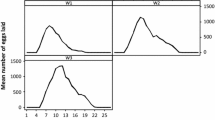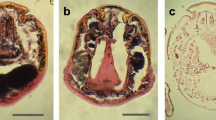Abstract
The structure and size of the eggs and layers of eggshells of some ticks of veterinary importance in Nigeria were studied. The ticks included Amblyomma variegatum, Boophilus decoloratus, B. geigyii, Hyalomma Impressum, H. impeltatum, H. truncatum and H. rufipes. The embryonic development of the eggs from the day of oviposition to hatching was also studied.
The freshly laid egg was found to possess 10 protuberances, and the biggest of them are the anterior and posterior ones. The eggs of A. variegatum were found to be the longest, and those of H. truncatum the shortest. The eggshell of all the species is two-layered on one lateral side and three-layered on the other; the middle layer originating from the anterior and posterior protuberances. Several phases of embryonic development are described. The major difference between the embryonic development of the eggs of A. variegatum and that of the others is that there are always phases during which the egg becomes canoe-shaped and later folds back to the normal egg shape. Eggs of B. decoloratus occasionally developed this way as well as those of some Hyalomma species when incubated at 37°C. The period of accomplishment of each phase of development was shortened by high temperatures. Observations on the occlusion periods of various types of eggs showed that the very small eggs would not hatch into larvae. The relevance of these observations to field tick control is highlighted, while the necessity of following up these studies with electron microscopic views of some aspects of the results is stressed.
Similar content being viewed by others
References
Akinboade O. A. and Dipeolu O. O. (1981) Experimental transmission of Babesia bigemina to calves with larval extracts of Boophilus decoloratus with observations on the effect of temperature. Proceedings of the National Symposium on Control of Ticks and Tick-borne Diseases in Nigeria (in press).
Akinboade O. A., Dipeolu O. O. and Adetunji A. (1980) Experimental transmission of Babesia bigemina and Anaplasma marginale to calves with the larvae of Boophilus decoloratus. Zentbl. VetMed. (in press).
Arthur D. R. (1962) Ticks and Diseases. Oxford, Pergamon Press.
Bonnet A. (1907) Recherches sur l’anatomie comparee et le développement Ixodes. Ann. Univ. Lvons 20, 10–20.
Campbell I. A. (1946) Nature, Lond 157, 412.
Dipeolu O. O. (1975a) The incidence of ticks of Boophilus species on cattle, sheep and goats in Nigeria. Trop. Arum. Hlth Production 7, 35–39.
Dipeolu O. O. (1975b) Survey of tick infestation in the trade cattle and sheep and goats in Nigeria. Bull. Anim. Hlth Production Africa 23, 165–172.
Dipeolu O. O. (1976) Tick paralysis in a sheep caused by nymphs of Amblyomma variegatum. Z. Parasitkde. 49, 293–294.
Dipeolu O. O. and Ogunji F. O. (1977a) Studies on ticks of veterinary importance in Nigeria. I. On the development of the ixodid ticks Amblyomma variegatum Fabricius 1794 and Hyalomma rufipes Koch 1844 under quasi natural conditions in Nigeria. J. pharmaceutical medical Sciences 1, 245–248.
Dipeolu O. O. and Ogunji F. O. (1977b) Studies on ticks of veterinary importance in Nigeria: III. The changes in the blood picture of sheep experimentally infested with the ticks Amblyomma variegatum and Hyalomma rufipes. Bull. Anim. Production Africa 25, 25–32.
Dipeolu O. O. and Ogunji F. O. (1977c) The transmission of Theileria annulata to a rabbit by the larvae of the tick Hyalomma rufipes. J. Lab. Anim. 11, 39–40.
Dipeolu O. O. and Ogunji F. O. (1980a) Studies on ticks of veterinary importance in Nigeria. II. Oviposition and occlusion patterns of Amblyomma variegatum Fabricius 1874 in relation to state of engorgement. Bull. Anim. Production Africa 28, 260–280.
Dipeolu O. O. and Ogunji F. O. (1980b) Laboratory studies on factors influencing the oviposition and ecclo-sion patterns of Amplyomma variegatum females. Folia parasit. 27, 257–264.
Enyenihi U. K. (1972) Studies on the bionomics and epi-zootiology of Neoascaris vitulorum in Nigeria: the effect of temperature on development, longevity and infectivity of N. vitulorium eggs. J. W. Afr. Sei. Ass. 17, 25–33.
Hughes T. E. (1950) The embryonic development of the mite Tyroglyphus farinae Linnaeus 1758. Proc. zool. Soc. Lond. 119, 260–264.
Mohammed A. N. (1974) The seasonal incidence of ixodid ticks of cattle in Northern Nigeria with particular reference to their role in the transmission of bovine piroplasma. Ph.D. thesis, Ahmadu Bello University, Nigeria.
Mohammed A. N. (1976) The seasonal incidence of ixodid ticks in Northern Nigeria. Bull. Anitn. Production Africa 25, 273–293.
Strickland K. L. (1961) Studies on the ticks of domestic animals of Northern Nigeria: a preliminary to disease investigation. M.Sc. thesis, Trinity College, Dublin.
Unsworth K. (1952) The ixodid parasites of cattle in Nigeria with particular reference to the northern territories. Ann. trop. Med. Parasit. 46, 331–336.
Wagner J. C. (1893) On the embryology of the mites, segmentation of the ovum, origin of the germinal layers and development of the appendages in Ixodes. An. Mag. nat. Hist. 11, 214–220.
Author information
Authors and Affiliations
Rights and permissions
About this article
Cite this article
Dipeolu, O.O. Studies on Ticks of Veterinary Importance in Nigeria—IV. Microscopic Observations on Embryonic Development of Eggs of Some Ticks. Int J Trop Insect Sci 3, 219–226 (1982). https://doi.org/10.1017/S174275840000583X
Received:
Published:
Issue Date:
DOI: https://doi.org/10.1017/S174275840000583X




